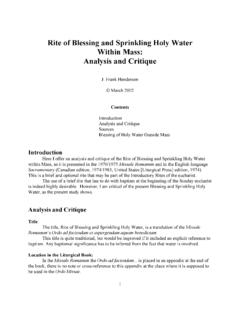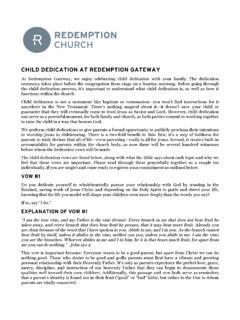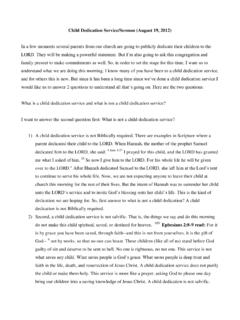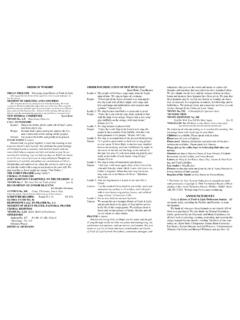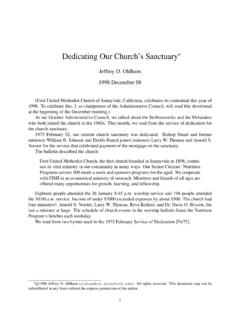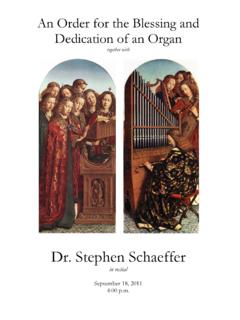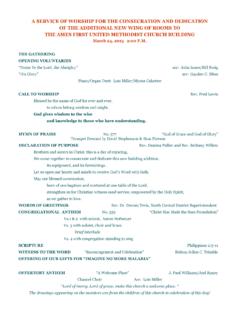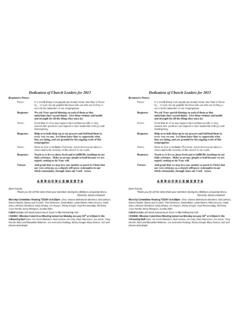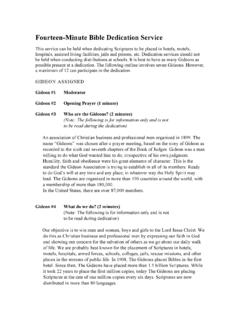Transcription of Blessing of Households and Dedication of the Domestic …
1 1 Blessing of Householdsand Dedication of the Domestic ChurchJ. Frank HendersonFrank Henderson s Site on Liturgy and Medieval J. Frank Henderson 2001 ContentsIntroductionGatheringRemembering BaptismBlessing of RoomsFront Door as EntranceLiving RoomKitchenBedroom (Couple)Bedroom (Single Adult)Bedroom (Child or Children)Bedroom (Other)BathroomBlessing of Dining Room, Table and MealDining RoomThe TableThe MealConclusionFront Door as ExitBlessing and Sending ForthAppendix: Additional Rooms2 IntroductionThe Blessing of Households (or houses or homes) is part of the heritage of some Christian traditions, and oneversion of such a Blessing liturgy is presented here. It is important to explain the key terms used in the title of this liturgy: Blessing , household , Domestic is meant by these words, and why is household used instead of house or home or family ?
2 BlessingAt first glance it may seem that the Blessing of Households has to do with the space or dwelling involved. Theplace, however, is secondary. The primary focus of such liturgies is the people who live in the dwelling placeand the use that they make of that place and its several parts. Blessing , as used here, has three dimensions or levels of meaning. First, those who celebrate these liturgiesbless God. That is, they acknowledge that the place in which the household dwells ultimately is God s gift; inresponse, they thank God for this , participants in these liturgies ask God s Blessing on the household . That is, they pray that God bepresent with all who dwell in that place. As God is never absent from any place, this is really a prayer that thehousehold be conscious of and experience the presence of , people pray that this household be an instrument or means of God s Blessing in society and all ofcreation.
3 That is, the household is called to be compassionate toward persons who have no housing or whosehousing is inadequate. Furthermore, the household is called to work for the transformation of society so thatthe dignity and needs of all persons will be served through the availability of adequate , liturgies of Blessing Households are not thought of as ways of making a place or the people who livethere holy as if they were un-holy or profane before. Instead, dwellings are already holy because they arepart of God s creation; people who live in them are also holy because they are made in the image and likenessof God. These liturgies therefore affirm this holiness and give thanks for it. They also provide opportunities toaccept the responsibilities that go with holiness, and to make a commitment to lives of considerations complicate the naming of this type of liturgy.
4 Thus one might justifiably say Blessing of Households , or Blessing over Households , or Blessing for Households , or Blessing in Households , or Blessing by Households . Here I have kept the more traditional of with the understanding that no single prepositionreally is , Home, household , Family, Domestic ChurchPeople generally reside in buildings, and these may be of various kinds and have a variety of names. Thus some3live in houses or apartments. Some live in religious institutions such as convents and monasteries. Some live inhealth-care institutions such as hospitals and nursing homes. Those in military service live in barracks orquarters. Some live in hotels or boarding houses or hostels. Some live in prisons or other correctional or penalinstitutions. And some, unfortunately, live without adequate housing or permanent preparing the liturgies of Blessing or Dedication presented here, I have primarily had houses and apartmentsin mind.
5 However, with appropriate adaptations these liturgies may also be of use in other situations as well, butthese adaptations have not been worked out a house or apartment or other dwelling place is occupied by persons, they usually become homes; barearchitectural spaces are transformed by the lives of the people who reside there. This also applies to some othertypes of dwelling places, though other places may never become a term household is intended to shift the focus from the space or place to the people who dwell obviously come in various sizes and configurations. For example, a household may be a singleperson living alone, or several single persons, or a couple, or a couple with their children. Here I try to includeall of these, and sometimes provide separate texts for Households of one and Households of two or more. The term family refers to one particular type of household ; because I am thinking more broadly, I generally donot use this contemporary Roman Catholic thought, the household is sometimes referred to as the Domestic church .
6 Thisecclesial perspective on the household broadens the horizons of imagination and theology,and suggests new opportunities, challenges and responsibilities for the household and for the rest of the concept was influential in the preparation of these liturgies. However, because this term and concept arenot yet familiar and in wide-spread use, I generally use the term household rather than Domestic church ,though the title includes both. Those who wish may freely replace the former with the of the LiturgyThis Blessing of Households and Dedication of the Domestic church has five main parts. In the Gatheringthe participants come together physically and are named and welcomed. The purpose of the liturgy is stated,and the celebration Baptism: The doorway and foundation of the religious life of the household is baptism, and thisis recalled and celebrated right at the beginning of the liturgy.
7 In addition, the use of water engages the wholebody - and can be fun as of Rooms: In this part of the liturgy, all go from room to room throughout the house or apartment,beginning with the front doorway and continuing in the living room, kitchen, bedrooms, and bathroom. Persons,uses, memories and intentions are named that are particularly relevant in each case. (An appendix providessimilar materials for the space where washing and ironing are done, where there is discussion and debate, forthe guest room, work room, den or study, garage, basement, and for any other room.)In each room the liturgy follows the same pattern, beginning with (1) an initial Blessing of God, (2) a statement4of ecclesial affirmation, and (3) a prayer. (4) Biblical saints are named -- based on the scriptural reading thatfollows; their presence is invoked as companions of the household .
8 (5) The reading tells a story of biblicalpersons and dwelling places. (6) A response highlights another biblical insight regarding dwelling places andhouseholds. (7) An appropriate action usually follows, and this part of the liturgy concludes with (8)spontaneous statements of hopes and dreams and (9) spontaneous prayers of of Dining Room, Table and Meal: The dining room and its table -- whatever architectural shape thistakes or furniture it may actually be -- are given particular emphasis in this liturgy, and a meal is : This section recognizes the front door as exit from the household into the world, and includes finalblessings and a sending : As already mentioned, texts for additional rooms are provided to Use these Liturgical Resources1. The liturgy presented here should be regarded as simply a suggestion or model or resource. It is intended tobe flexible and open to adaptation and This liturgy does not have to be celebrated in its entirety or all at the same time.
9 Parts may be used ondifferent occasions. Parts may also be repeated as the membership of the household changes or as the dwellingplace The liturgy presented here may be enhanced by song, dance or other artistic Though serious, this liturgy is not meant to be somber or particularly formal. It should be an enjoyableexperience, and should not be If the household includes children, they are invited to participate as fully as they are Guests -- including children -- are also invited to participate as fully as they are able. The Planning Process1. Go through the liturgy as presented here and decide what rooms and other main parts you wish to includeon this occasion. Other rooms and parts may be set aside as inappropriate or for use on another Look closely at the prayers and readings that are suggested here. Where alternatives are given, choose theone(s) to be used.
10 If desired, rewrite texts given here, or write new ones. A few prayers have deliberately beenleft unfinished; participants will need to complete them in their own Biblical passages are quoted from the New Revised Standard Version. Those who use this liturgy maysometimes wish to paraphrase this version or use alternative images of God or The frequently used response, Thanks be to God, may be replaced by other spoken or sung Look closely at the actions that are suggested here and imagine how they will be carried out: the movementof persons, the use of water, flowers, candles and other lights, the meal, etc. What materials and otherpreparations are required?6. Consider who will be invited as Decide who will preside in this liturgy; this role may be shared by several persons. Decide also who will leadspecific prayers and read individuals readings.


